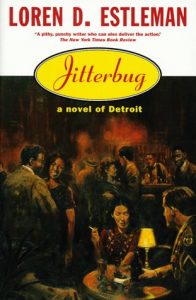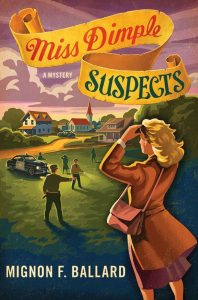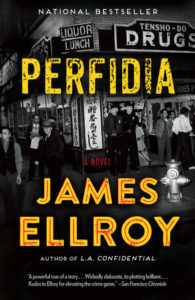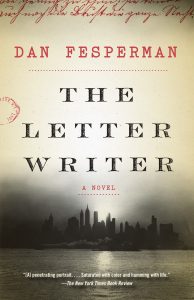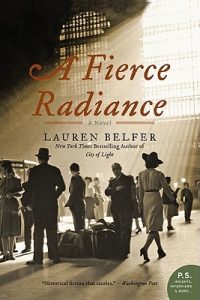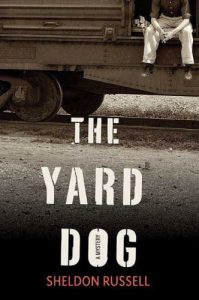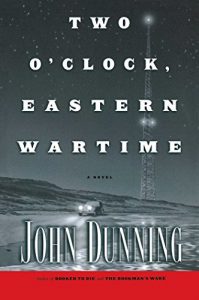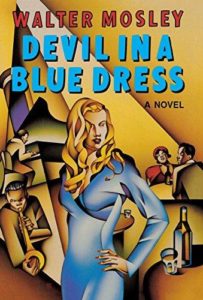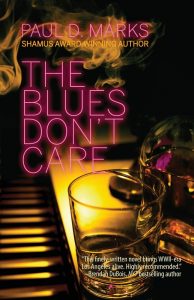When most people think of books set during World War II, they’re probably thinking of: Pearl Harbor, machine gun nests, goose-stepping Nazis, concentration camps, allied troops storming the beaches, blitzkrieg, D-Day, the flag raising at Iwo Jima, the Bataan Death March, B-17 raids over Europe and more. They’re probably not thinking about the American home front. But the people at home were just as much a part of the war effort as those on the front lines.
When I was researching my book The Blues Don’t Care, set on the home front in Los Angeles during World War II, I found there was more to it than what most people usually consider. When you think of the American home front you might visualize things like “mom and apple pie,” Carole Lombard on a war bond drive, the Andrews Sisters belting out “Boogie Woogie Bugle Boy” at the local USO, Rosie the Riveter pushing up her sleeves and flexing her muscles, and that famous little cartoon of the war Kilroy, as in “Kilroy was here”, which popped up all over the country on walls and bathroom stalls. In other words, the glamorized Hollywood version of the home front.
We tend to forget that the home front wasn’t always a warm, inviting place. Our country was off fighting in foreign lands, island hopping in the Pacific and attempting to liberate Europe from the threat of Nazism, but at home things were bubbling under the surface. Racial tensions, social inequities, xenophobia, fear of anyone different, changing morals and values.
Contemporary writers are now rediscovering this era and setting and are intrigued by the contradictions that existed. Here are a few crime fiction novels worth checking out for their perspective on the American home front during the 1940s war years from the distance of the 21st century:
Jitterbug (2000) by Loren D. Estleman
Detroit, Michigan. The auto industry has turned its factories to full-time war production. As most of the able-bodied young men have gone to war, the police department consists of misfits and those too old to enlist in the military. Blacks are moving up from the South into the city and working in the factories shoulder to shoulder with whites, but racial tensions are high. Rationing is in force and people begin to hoard ration coupons. Add into the mix a serial killer dubbed “Kilroy”—named after the famous “Kilroy Was Here” figure—who is a self-appointed judge, jury and executioner. By impersonating a military officer he is able to exact his justice at the end of a bayonet. Coupon hoarders and goldbrickers are among his victims. Lieutenant Maximillian “Zag” Zagreb must find and stop the killer.
American industry, and the Detroit auto industry in particular, built the machinery that helped win the war. Franklin Roosevelt called it the “Arsenal of Democracy”. The race to build faster and better machinery forever changed the city. Estleman’s take on the home front is a world that is troubled and on the verge of change. A place that is at war from within, as different races and ethnicities struggle to get along.
Jitterbug is one installment in a series of crime novels Estleman set in Detroit. He said this in the afterword of Thunder City: “In these seven books I have attempted to tell the story of America in the twentieth century through the microcosm of Detroit, the one city whose history mirrors precisely the history of the United States of America.”
Estleman brings WWII Detroit alive with memorable characters and brilliant dialog.
Miss Dimple Suspects (2013) by Mignon F. Ballard
On the cozy side of things, Mignon Ballard sets her Miss Dimple mystery series in a rural small town in Georgia during the war. Miss Dimple Kilpatrick is a first-grade school teacher at Elderberry Grammar School. And, although the books are filled with the things you’d expect in a cozy mystery: a quaint village, loveable characters, Georgia peaches, cats and Southern charm, it also deals with war-time unpleasantness such as economic hardships, rationing and anti-Japanese sentiments.
Miss Dimple Suspects is the third in the series and begins with the search for a missing child. Miss Dimple finds the child, aided by an elderly artist and her young Japanese companion. When the artist is later found dead, the town suspects the Japanese girl. And of course Miss Dimple uses her amateur sleuthing skills to find the truth.
Unlike the big cities, rural communities experienced the war in a different way. With many farm workers in Georgia either moving to the cities to work in defense factories or enlisting in the military. These rural communities struggled and many women had to take over traditionally male jobs. The American home front depicted in these books is one of courage and patriotism, but is also provincial, ignorant and fearful. However, at the same time, hopeful.
Ballard provides us with a nostalgic and heartwarming look at a place and time that was a turning point in history.
Perfidia (2014) and This Storm (2019) by James Ellroy
There’s no one better at diving into the deepest depths of corruption and betrayal than Ellroy. He immerses you in the times and doesn’t try to soften the blows. These two novels, set during the war, comprise the start of Ellroy’s Second L.A. Crime Series or Second L.A. Quartet. He reintroduces us to Kay Lake, (from The Black Dahlia) and Dudley Smith (also from the first L.A Quartet series). And he brings in real-life character William H. Parker, chief of the L.A.P.D. We are also introduced to a new character, Hideo Ashida, a Japanese-American crime lab expert.
Perfidia begins right after the bombing of Pearl Harbor and deals with the ritualistic murder of a Japanese-American family. Of course, there’s corruption, police brutality, and anti-Japanese racism among all the other vices and sins of Ellroy’s world.
This Storm is the second book in the new L.A. Quartet saga. A body is uncovered in Griffith Park during a storm. A train carrying gold bars from the U.S. mint is robbed and three men are killed in an opium sex den. The crimes are all somehow connected. Hideo Ashida, Kay Lake and Dudley Smith are again featured along with a new character, Joan Conville, who becomes Ashida’s assistant. While all this is happening Japanese Americans are being rounded up for internment camps and war profiteers are looking for new scams.
These two books are set amongst the fear and angst of the times. In 1942 a Japanese submarine shelled an oil facility north of Los Angeles near Santa Barbara, which led to fear and paranoia over possible future attacks and city-wide black outs. Los Angeles also had a large Japanese American population, many of whom were interned in camps.
People seem to either love or hate Ellroy’s writing. It may be hard for some to get past his staccato style. But you can’t deny that he is a master of storytelling and that he has an amazing way of uncovering the historic Los Angeles and revealing its ugly underbelly.
The Letter Writer (2016) by Dan Fesperman
Woodrow Cain leaves behind the questionable death of his partner and his job as a small town North Carolina cop for a job with the NYPD during WWII. During his investigation of a body found in the Hudson River he meets a man named Danziger, who writes letters for illiterate immigrants. Cain, a Southerner in New York City, is a fish out of water, and Danziger becomes his guide through a world of mobsters, corruption and Nazi sympathizers.
The premise is supposedly inspired by the true story of a deal between the mob and the U.S. Navy to protect the waterfront from Nazi saboteurs. An interesting piece of history and further evidence that the home front played an even more pivotal role in the war than we might realize.
Fesperman weaves an intriguing and gritty tale that provides a deeper understanding of what New York City must have been like during the war.
A Fierce Radiance (2010) by Lauren Belfer
Life Magazine photojournalist Claire Shipley is writing a story on a breakthrough new drug being developed for use by the military in the early days of World War II—penicillin. Believing that the penicillin wonder drug will help prevent deaths and keep military force numbers high, the U.S. government pushes for the development of the drug. When one of the researchers is killed, it becomes clear that the stakes involved in developing this drug are very high.
This book is more of a romance/thriller, but does show how our world has changed and how the war helped spur great scientific advancements. Some might find it a bit of a soap opera, but Belfer delivers a well-told and moving story with well-researched historical details and descriptive writing.
The Yard Dog (2009) by Sheldon Russell
This is the first in the Hook Runyon series and features a unique character, “Hook,” a one-armed railroad cop in Oklahoma. Hook lives in an old caboose with his collection of rare books and not-so-rare liquor. His job is to run off hobos and pickpockets from the railway yards. The rail yard setting reminds us that the country has just come out of the Great Depression and life is not all that great for a lot of people.
A little remembered part of our history is the number of POW camps that were scattered across the country. So, when one of Hook’s friends is run over by a rail car, he doesn’t believe it’s an accident. His investigation involves a nearby Nazi POW camp and Dr. Reina Kaplan, a Jewish doctor in charge of re-educating the Nazi prisoners.
As with rural Georgia, Oklahoma also experienced a move away from rural areas towards urban areas. And women began to take on previously male jobs. Things could never go back to being the same after the war. Russell recreates the WWII home front atmosphere and loneliness of the Oklahoma landscape. He makes it so real and compelling that you feel you are there.
Two O’Clock, Eastern Wartime: A Novel (2001) by John Dunning
“Wartime” was the name given to daylight savings time when it first began, hence the title of the novel. Set in the world of radio broadcasting, the story revolves around a radio script writer helping his girlfriend find her missing father. At the same time it gives us a look into what life was like during the war and the sense paranoia caused by the fear that German spies might be infiltrating the country.
The plot is twisty and complex. John Dunning, author of the Cliff Janeway bookseller mysteries, writes with beautifully detailed understanding of radio and its impact during the war.
Devil in a Blue Dress (1990) by Walter Mosley
My last entry is not set during World War II, but right after the war, and was not written in the 21st century, but it bears mentioning because it probably influenced a lot of current writers to look back towards the WWII era.
Devil in a Blue Dress introduced us to Easy Rawlins, an African-American war veteran who, in order to make ends meet, takes a questionable job trying to locate a beautiful blonde who has a thing for black jazz clubs. Mosley’s book showed people a side of the post-war American home front that many had never seen. And in his characters, Easy and his psychopathic sidekick (and I use that term lovingly), Mouse, he created two of the most memorable fiction characters in recent years.
Black war veterans faced a different kind of homecoming than whites. Often they were perceived as a threat because of the training and self-confidence that the war had given them. And, after risking their lives, they came home to a country that still didn’t recognize their civil rights. They often faced violence upon their return instead of a hero’s welcome.
Mosley writes with beautiful prose and sharp dialogue and delivers insight into an era that we need to understand today more than ever.
***
This is just a sampling of the home front fare available. As you see, books set on the American home front may not involve tanks, bunkers or bombers, but there is plenty of intrigue and violence to be found hidden under the sparkling cities and welcoming home town veneers.
***


